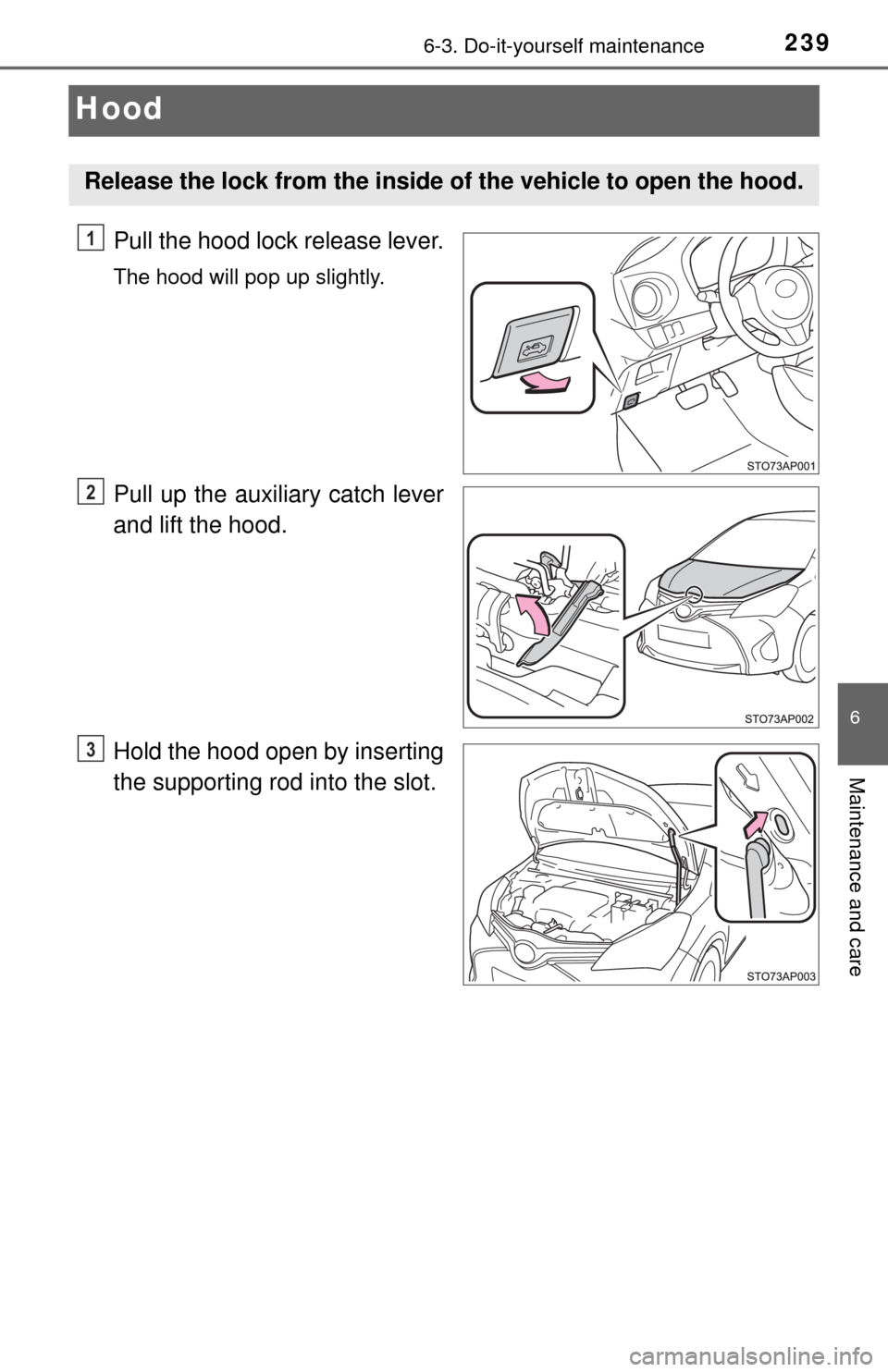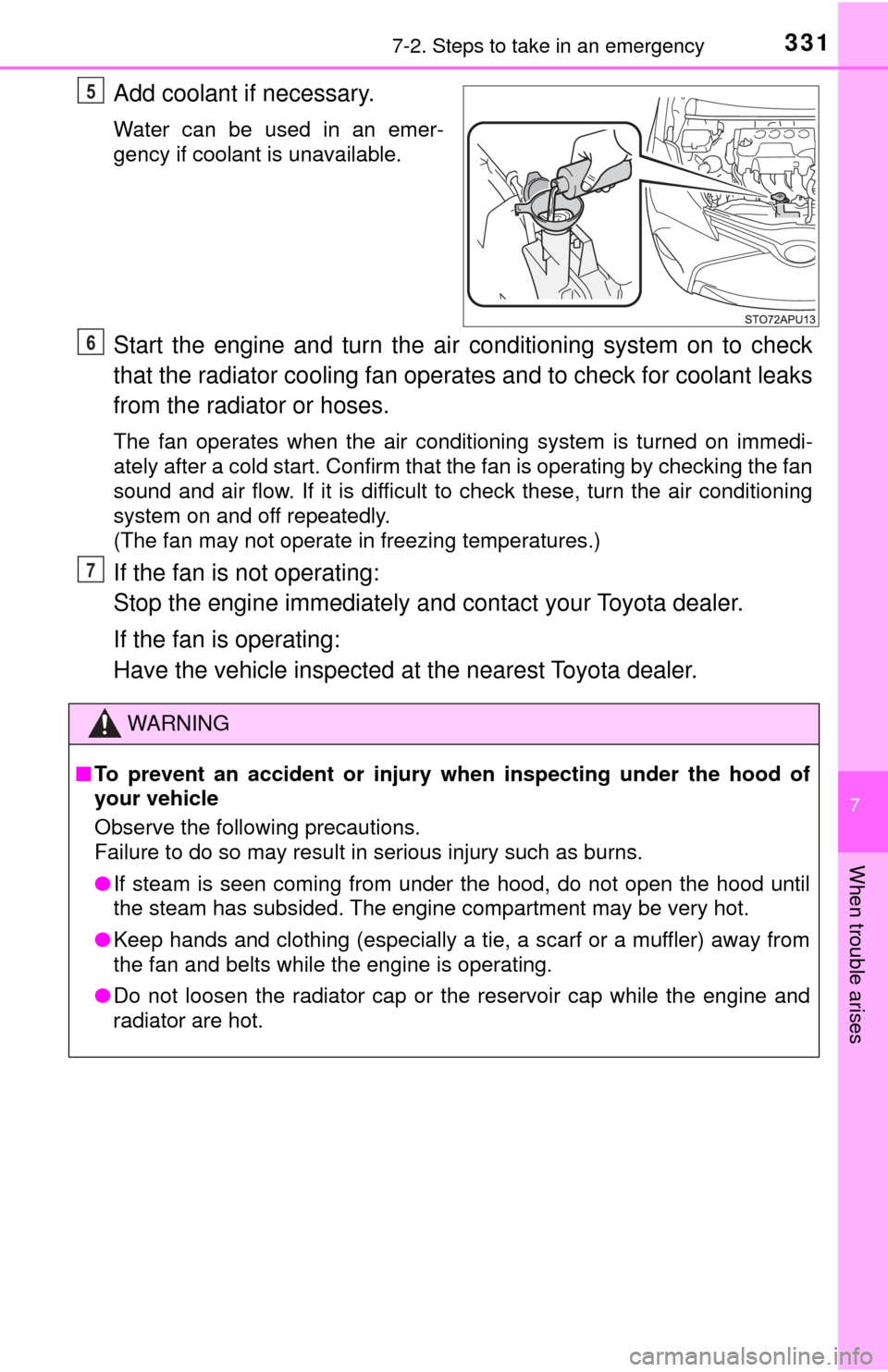2017 TOYOTA YARIS hood open
[x] Cancel search: hood openPage 13 of 396

13Pictorial index
Wipers . . . . . . . . . . . . . . . . . . . . . . . . . . . . . . . . . . . . . . . P. 150, 153
Precautions against winter season . . . . . . . . . . . . . . . . . . . . . P. 197
Fuel filler door . . . . . . . . . . . . . . . . . . . . . . . . . . . . . . . . . . . . P. 156
Refueling method . . . . . . . . . . . . . . . . . . . . . . . . . . . . . . . . . . . P. 156
Fuel type/fuel tank capacity . . . . . . . . . . . . . . . . . . . . . . . . . . . P. 340
Tires . . . . . . . . . . . . . . . . . . . . . . . . . . . . . . . . . . . . . . . . . . . . P. 253
Tire size/inflation pressure . . . . . . . . . . . . . . . . . . . . . . . . . . . . P. 345
Winter tires/tire chain . . . . . . . . . . . . . . . . . . . . . . . . . . . . . . . . P. 198
Checking/rotation . . . . . . . . . . . . . . . . . . . . . . . . . . . . . . . . . . . P. 253
Coping with flat tires . . . . . . . . . . . . . . . . . . . . . . . . . . . . . . . . P. 312
Hood . . . . . . . . . . . . . . . . . . . . . . . . . . . . . . . . . . . . . . . . . . . . P. 239
Opening . . . . . . . . . . . . . . . . . . . . . . . . . . . . . . . . . . . . . . . . . . P. 239
Engine oil . . . . . . . . . . . . . . . . . . . . . . . . . . . . . . . . . . . . . . . . . P. 340
Coping with overheat . . . . . . . . . . . . . . . . . . . . . . . . . . . . . . . . P. 330
Headlights/daytime running lights . . . . . . . . . . . . . . . . . . . . P. 145
Fog lights
* . . . . . . . . . . . . . . . . . . . . . . . . . . . . . . . . . . . . . . . P. 148
Turn signal lights . . . . . . . . . . . . . . . . . . . . . . . . . . . . . . . . . . P. 143
Stop/tail lights . . . . . . . . . . . . . . . . . . . . . . . . . . . . . . . . . . . . P. 145
License plate lights . . . . . . . . . . . . . . . . . . . . . . . . . . . . . . . . P. 145
Back-up lights
Shifting the shift lever to R . . . . . . . . . . . . . . . . . . . . . . . . P. 139, 142
4
5
6
7
Light bulbs of the exterior lights for driving
(Replacing method: P. 278, Watts: P. 346)
*: If equipped
8
9
10
11
12
13
Page 52 of 396

521-1. For safe use
Safety information for children
●It is recommended that children sit in the rear seats to avoid acci-
dental contact with the shift lever, wiper switch, etc.
● Use the rear door child-protector lock or the window lock switch to
avoid children opening the door while driving or operating the
power window accidentally.
● Do not let small children operate equipment which may catch or
pinch body parts, such as the power window, hood, back door,
seats, etc.
Observe the following precautions when children are in the vehi-
cle.
Use a child restraint system appropriate for the child, until the
child becomes large enough to pr operly wear the vehicle’s seat
belt.
WARNING
Never leave children unattended in the vehicle, and never allow children to
have or use the key.
Children may be able to start the vehicle or shift the vehicle into neut\
ral.
There is also a danger that children may injure themselves by playing with
the cigarette lighter, the windows or other features of the vehicle. In addi-
tion, heat build-up or extremely cold temperatures inside the vehicle can be
fatal to children.
Page 177 of 396

1774-5. Toyota Safety Sense C
4
Driving
■If the PCS warning light flashes or illuminates
The pre-collision system may be tempor arily unavailable or there may be a
malfunction in the system.
● In the following situations, the warning light will be cleared and the system
will become operational when normal operating conditions return:
• When the area around the front sensor is hot, such as after the vehicle
has been parked in the sun
• When the windshield is fogged up or covered with condensation or ice (→ P. 205)
• When the front sensor or the area around either sensor is cold, such as in
an extremely cold environment
• If the area in front of the front sensor is obstructed, such as when the hood is open
● If the PCS warning light continues to flash or illuminate, the system may be
malfunctioning. Have the vehicle inspected by your Toyota dealer immedi-
ately.
■ If VSC is disabled
●If TRC and VSC are disabled (→P. 194), the pre-collision brake assist and
pre-collision braking functions are also disabled. However, the pre-collision
warning function will still operate.
● The PCS warning light illuminates.
Page 239 of 396

2396-3. Do-it-yourself maintenance
6
Maintenance and care
Hood
Pull the hood lock release lever.
The hood will pop up slightly.
Pull up the auxiliary catch lever
and lift the hood.
Hold the hood open by inserting
the supporting rod into the slot.
Release the lock from the inside of the vehicle to open the hood.
1
2
3
Page 240 of 396

2406-3. Do-it-yourself maintenance
WARNING
■Pre-driving check
Check that the hood is fully closed and locked.
If the hood is not locked properly, it may open while the vehicle is in motion
and cause an accident, which may result in death or serious injury.
■ When opening the hood
Make sure the rod supports the hood securely from falling down on to your
head or body.
NOTICE
■When closing the hood
Be sure to return the support rod to its clip before closing the hood. Closing
the hood without returning the support rod properly could cause the hood to
bend.
Page 327 of 396

327
7
When trouble arises
7-2. Steps to take in an emergency
If the vehicle battery is discharged
If you have a set of jumper (or booster) cables and a second vehicle
with a 12-volt battery, you can jump start your vehicle by following the
steps below.
Open the hood. ( →P. 239)
Connect the jumper cables according to the following procedure:
Connect a positive jumper cable clamp to the positive (+) battery
terminal on your vehicle.
Connect the clamp on the other e nd of the positive cable to the
positive (+) battery terminal on the second vehicle.
Connect a negative cable clamp to the negative (-) battery termi-
nal on the second vehicle.
Connect the clamp at the other end of the negative cable to a
solid, stationary, unpainted metallic point away from the battery
and any moving parts, as shown in the illustration.
The following procedures may be used to start the engine if the
vehicle’s battery is discharged.
You can also call your Toyota de aler or a qualified repair shop.
1
2
1
2
3
4
Page 331 of 396

3317-2. Steps to take in an emergency
7
When trouble arises
Add coolant if necessary.
Water can be used in an emer-
gency if coolant is unavailable.
Start the engine and turn the air conditioning system on to check
that the radiator cooling fan opera tes and to check for coolant leaks
from the radiator or hoses.
The fan operates when the air conditioning system is turned on immedi-
ately after a cold start. Confirm that the fan is operating by checking the fan
sound and air flow. If it is difficult to check these, turn the air conditioning
system on and off repeatedly.
(The fan may not operate in freezing temperatures.)
If the fan is not operating:
Stop the engine immediately and contact your Toyota dealer.
If the fan is operating:
Have the vehicle in spected at the nearest Toyota dealer.
5
WARNING
■To prevent an accident or injury when inspecting under the hood of
your vehicle
Observe the following precautions.
Failure to do so may result in serious injury such as burns.
● If steam is seen coming from under the hood, do not open the hood until
the steam has subsided. The engine compartment may be very hot.
● Keep hands and clothing (especially a tie, a scarf or a muffler) away from
the fan and belts while the engine is operating.
● Do not loosen the radiator cap or the reservoir cap while the engine and\
radiator are hot.
6
7
Page 389 of 396

389Alphabetical index
FuelCapacity ................................ 340
Fuel gauge .............................. 77
Fuel pump shut off system.... 301
Information ............................ 347
Refueling............................... 156
Type .............................. 156, 340
Warning light ......................... 304
Fuel consumption Average fuel consumption ...... 81
Instantaneous fuel
consumption ......................... 81
Fuel filler door.......................... 156
Refueling............................... 156
Fuel pump shut off system ..... 301
Fuses ........................................ 273
Gas station information .......... 396
Gauges ....................................... 77
Glove box ................................. 215
Hazard lights Switch ................................... 292
Head restraints ........................ 104
Headlights ................................ 145 Automatic High Beam ........... 183
Light switch ........................... 145
Replacing light bulbs............. 279
Wattage ................................ 346
Heaters ..................................... 202 Manual air conditioning system ......... ....................... 202
Outside rear view mirrors...... 206
High mounted stoplight Replacing light bulbs............. 288
Hood ......................................... 239 Open ..................................... 239
Hooks
Retaining hooks (floor mat)..... 22
Horn .......................................... 107 Identification ............................ 337
Engine .................................. 338
Vehicle .................................. 337
Ignition switch
(engine switch) ...................... 136
Illuminated entry system ........ 213
Immobilizer system ................... 67
Indicators ................................... 74
Initialization Maintenance data ................. 231
Items to initialize ................... 365
Tire pressure warningsystem .......... ...................... 254
Inside rear view mirror ............ 109
Instrument panel light control ...................................... 78
Interior light ............................. 212 Switch ................................... 212
Wattage ................................ 346
Jack Positioning a floor jack.......... 241
Vehicle-equipped jack .......... 313
Jack handle .............................. 313
G
H
I
J